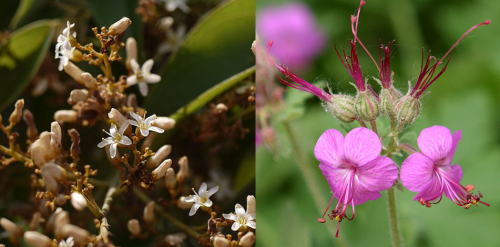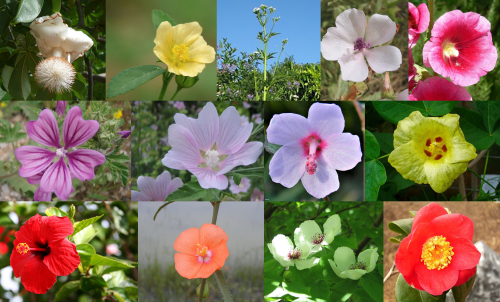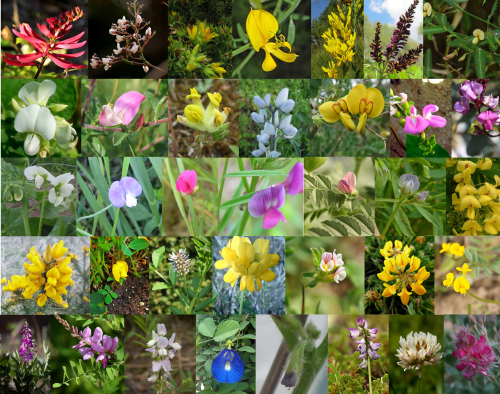by Piter Kehoma Boll
Finally a new post in the History of Systematic series. This is the sixth part of Linnaeus’ classification of plants. See parts 1, 2, 3, 4, 5, 7, 8 and 9. Here, I’ll present thre more classes which are characterized by having the stamens arising from a common base in the flower.
16. Monadelphia (“single brothers”)
“Husbands, or brothers, arising from one base”, i.e., the filaments of the stamens are fused in a single body.
16.1 Monadelphia Pentandria (“single brothers, five males”), five stamens fused into a single structure: Waltheria (gray mallows), Hermannia (hermannias), Bombax (cotton trees), Melochia (melochias).

These 5 species belonged Linnaeus’ Monadelphia Pentandria (from left to right): sleepy morning (Waltheria indica), three-leaved hermannia (Hermannia trifoliata), chocolateweed (Melochia corchorifolia), red cotton tree (Bombax aculeatum, now Bombax ceiba). Credits to J. M. Garg (sleepy morning), C. E. Timothy Paine (hermannia), Jeevan Jose (chocolatewed), Dinesh Valke (cotton tree).
16.2 Monadelphia Decandria (“single brothers, ten males”), ten stamens fused into a single structure: Connarus (Indian zebrawood), Geranium (geraniums), Hugonia (a species of doubtful identity).

The above species were put by Linnaeus in the order Monadelphia Decandria: Indian zebrawood (Connarus monocarpus, left) and bigroot geranium (Geranium macrorhizum, right). Credits to Dinesh Valke (zebrawood) and Wikipedia user Hardyplants (geranium).
16.3 Monadelphia Polyandria (“single brothers, many males”), many stamens fused into a single structure: Stewartia (silky camellia), Napaea (glade mallow), Sida (fanpetals), Adansonia (baobabs), Pentapetes (gojikas), Gossypium (cottons), Lavatera (tree mallows), Malva (mallows), Malope (mallow worts), Urena (caesarweeds), Alcea (hollyhocks), Hibiscus (hibiscuses), Althaea (marshmallows), Camellia (camélia).

Linnaeus classified the above species as Monadelphia Polyandria (from left to right, top to bottom): common baobab (Adansonia digitata), arrowleaf fanpetal (Sida rhombifolia), glade mallow (Napaea dioica), common marshmallow (Althaea officinalis), common hollyhock (Alcea rosea), common mallow (Malva sylvestris), garden tree mallow (Lavatera thuringiaca), common caesarweed (Urena lobata), Levant cotton (Gossypium herbaceum), Chinese hibiscus (Hibiscus rosa-sinensis), gojika (Pentapetes phoenicea), silky camellia (Stewartia malacodendron), common camellia (Camellia japonica). Credits to Jeevan Jose (fanpetal), Pablo Alberto Salguero Quiles (marshmallow), Stan Shebs (hollyhock), Joanna Voulgaraki (mallow), Bob Peterson (caesarweed), H. Zell (cotton), Andrew Fogg (hibiscus), Frank Vicentz (camellia), Wikimedia users Atamari (baobab), Botaurus stellaris (tree mallow), Melburnian (silky camellia), flickr users peganum (glade mallow), Lalithamba (gojika).
17. Diadelphia (“two brothers”)
“Husbands originating from a double base, as well as a double mother”, i.e., the filaments of the stamens are gathered in two bodies.
17.1 Diadelphia Pentandria (“two brothers, five males”), two structures formed of five fused stamens: Monnieria (monnieria).
17.2 Diadelphia Hexandria (“two brothers, six males”), two structures formed of six fused stamens: Fumaria (fumitories).
17.3 Diadelphia Octandria (“two brothers, eight males”), two structures formed of eight fused stamens: Polygala (milkworts), Securidaca (safeworts).

The plant to the left, the common fumitory (Fumaria officinalis) was in the order Diadelphia Hexandria, while the plant to the right, the common milkwort (Polygala vulgaris), was in the order Diadelphia Octandria. Credits to Isidre Blanc (fumitory) e Radio Tonreg (milkwort).
17.4 Diadelphia Decandria (“two brothers, ten males”), two structures formed of ten fused stamens: Amorpha (false indigo), Ebenus (ebonies), Erythrina (coral trees), Spartium (brooms), Genista (more brooms), Lupinus (lupins), Anthyllis (kidney vetches), Aeschynomene (jointvetches), Piscidia (), Borbonia (cape gorses), Aspalathus (more cape gorses), Ononis (restharrows), Crotalaria (rattlepods), Colutea (bladder sennas), Phaseolus (beans), Dolichos (longbeans, lablab bean), Orobus (vetchlings), Pisum (peas), Lathyrus (more vetchlings), Vicia (vetches), Astragalus (milkvetches), Biserrula (more milkvetches), Phaca (even more milkvetches), Psoralea (some trefoils), Trifolium (clovers or trefoils), Glycyrrhiza (licorices), Hedysarum (sweetvetches), Coronilla (more vetches), Ornithopus (bird’s-foot), Scorpiurus (scorpion’s-tails), Hippocrepis (horseshoe vetches), Medicago (alfalfas), Trigonella (fenugreek and allies), Glycine (soybeans), Clitoria (pigeonwings), Robinia (locusts, caraganes, riverhemps), Indigofera (indigos), Ulex (gorses), Cicer (chickpea), Ervum (lentils, vetches), Cytisus (laburnums and even more brooms), Galega (galegas), Lotus (bird’s-foot-trefoils), Arachis (peanut).

These 36 plants were included in the order Diadelphia Decandria (from left to right, top to bottom): coral bean (Erythrina herbacea), fishfuddle (Piscidia erythrina, now Piscidia piscipula), heart-shaped capegorse (Borbonia cordata, now Aspalathus cordata), weaver’s broom (Spartium junceum), dyer’s broom (Genista tinctoria), desert false-indigo (Amorpha fruticosa), Indian jointvetch (Aeschynomeme indica), blue rattlepod (Crotalaria verrucosa), field restharrow (Ononis arvensis), common kidney vetch (Anthyllis vulneraria), white lupin (Lupinus albus), bladder senna (Colutea arborescens), common bean (Phaseolus vulgaris), lablab bean (Dolichos lablab, now Lablab purpureus), common pea (Pisum sativum), hairy vetchling (Orobus hirsutus, now Lathyrus hirsutus), grass vetchling (Lathyrus nissolia), common vetch (Vicia sativa), Chickpea (Cicer arietinum), lentil (Ervum lens, now Lens culinaris), common laburnum (Cytisus laburnum, now Laburnum anagyroides), common gorse (Ulex europaeus), peanut (Arachis hypogaea), licorice (Glycyrrhiza glabra), scorpion vetch (Coronilla glauca), little white bird’s-foot (Ornithopus perpusillus), horseshoe vetch (Hippocrepis comosa), prickly scorpion’s-tail (Scorpiurus muricatus), alpine sweetvetch (Hedysarum alpinum), indigo (Indigofera tinctoria), common galega (Galega officinalis), Asian pigeonwing (Clitoria ternatea), common soybean (Glycine max), alpine milkvetch (Astragalus alpinus), white clover (Trifolium repens), Cretan ebony (Ebenus cretica). Credits to Everglades NPS (coral bean), Jon Richfield (capegorse), Bernd Haynold (dyer’s broom), Dinesh Valke (jointvetch), J. M. Garg (rattlepod), Kristian Peters (restharrow, vetch, bird’s-foot), Massimiliano Marcelli (lupin), Mauricio Laurente (bean), Bogdan Giuşcă (hairy vetchling), Carl Davies-CSIRO (chickpea), Christian Kooyman (lentil), Jean François Gaffard (laburnum), H. Zell (peanut), Carsten Niehaus (scorpion vetch), Isidre Blanc (horseshoe vetch), Hans Hillewaert (scorpion’s-tail, clover), Nicola Cocchia (galega), Tusli Bhagat (pigeonwing), Jörg Hempel (milkvetch), Rüdiger Kratz (ebony), flickr users jayeshpatil912 (fishfuddle) and Eskimo Potato (sweetvetch), Wikimedia users Hectonichus (weaver’s broom), AnRo0002 (false indigo, kidney vetch, bladder senna), Dalgial (lablab), Rasbak (pea), Sannse (grass vetchling), Rosser1954 (gorse), Pharaoh han (liquorice), Pancrat (indigo), vegetalist (soybean).
18. Polyadelphia (“many brothers”)
Husbands originating from more than two mothers, i.e., stamens are gathered in three or many bodies.
18.1 Polyadelphia Pentandria (“many brothers, five males”), more than two structures of five fused stamens: Theobroma (cacao and bay cedar).
18.2 Polyadelphia Icosandria (“many brothers, twenty males”), more than two structures of twenty fused stamens: Citrus (citrus fruits trees).
18.3 Polyadelphia Polyandria (“many brothers, many males”), more than two structures of many fused stamens: Hypericum (St. Johnswort), Ascyrum (St. Andrew’s cross).

The cacao tree (Theobroma cacao, left) was one of the members of the order Polyadelphia Pentandria; the citron (Citrus medica, middle left) was a member of the order Polyadelphia Icosandria; and the Balearic St. Johnswort (Hypericum balearicum, middle right) and the St. Andrew’s cross (Ascyrum hypericoides, now Hypericum hypericoides) were members of the order Polyadelphia Polyandria. Credits to H. Zell (cacao tree), Christer T Johansson (citron), Wikimedia user Eric in SF (St. Johnswort), Bob Peterson (St. Andrew’s cross).
With a few exceptions, most of the plants in these classes currently belong to the families Malvaceae and Fabaceae (Leguminosae) of flowering plants. I guess we still need three more posts on the plants and then we are done! I hope the next part won’t take so long.
– – –
References:
Linnaeus, C. (1758) Systema Naturae per Regna Tria Naturae…
– – –
*
All images are licensed under a Creative Commons Attribution-ShareAlike 4.0 International License.

Pingback: The history of Systematics: Plants in Systema Naturae, 1758 (Part 1) | Earthling Nature
Pingback: The history of Systematics: Plants in Systema Naturae, 1758 (Part 2) | Earthling Nature
Pingback: The history of Systematics: Plants in Systema Naturae, 1758 (Part 3) | Earthling Nature
Pingback: The history of Systematics: Plants in Systema Naturae, 1758 (Part 4) | Earthling Nature
Pingback: The history of Systematics: Plants in Systema Naturae, 1758 (Part 5) | Earthling Nature
Pingback: The history of Systematics: Plants in Systema Naturae, 1758 (Part 7) | Earthling Nature
Already finished the next parts?
Not yet, unfortunately. My doctorate is consuming too much of my time, but I’ll post the next part as soon as possible.
Pingback: The history of Systematics: Plants in Systema Naturae, 1758 (Part 8) | Earthling Nature
Pingback: The history of Systematics: Plants in Systema Naturae, 1758 (Part 9) | Earthling Nature
Pingback: The history of Systematics: Systema Naturae from 1758 to 1767-1770 | Earthling Nature